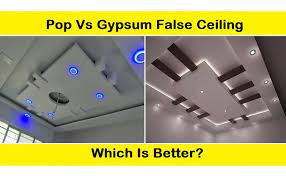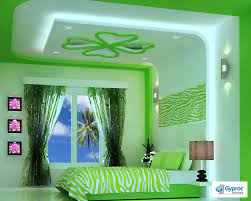Ceilings that are uninteresting are no longer a part of our lives. A beautifully crafted false ceiling will make your home look amazing when you remodel it. False ceilings can not only enhance the beauty of your home, but they also conceal unattractive AC ducting and electrical wiring. It is important to use high-quality materials to make it last. Two of the most popular materials for making a false ceiling are plaster of Paris (POP) and Gypsum boards. POP and Gypsum share certain properties, such as being bulky and heat-insulating. False ceilings made from these materials offer their advantages and disadvantages. They both use Gypsum for a base, but they are different.
This article will discuss the advantages and disadvantages of each.
Gypsum Boards
Gypsum plasterboard false ceilings are made of gypsum plasterboards. These plasterboards are attached to a metal frame and screwed to the soffit. There are fewer joints because gypsum plasterboard is available in larger sheets than POP sheets. To complete the joints, a jointing compound will be used. Gypsum plasterboard installation is quicker, easier, safer, and less messy than traditional methods. Gypsum plasterboard lasts longer than POP. Gypsum plasterboard is used to make false ceilings because of its hydrophobic properties.
Plasterboards, another name for Gypsum Boards, are made from Gypsum, which is hydrated calcium sulfurate and has a long shelf-life. Gypsum boards prefabricated in factories are then erected at the job site with metal frameworks. These boards come in three sizes: 4 x 6 feet; 4 x 8ft; and 4 x10 feet. They are also available in thicknesses as low as 9, 12 and 15mm. For long-term durability, only use high-quality, rust-resistant metal frames. These frames are used in areas that have central air-conditioning systems.
Gyproc is one of the most prominent manufacturers of plasters and ceiling boards made from Gypsum. Gyproc is a subsidiary of the Saint-Gobain Group. They are the world’s largest manufacturer of ceiling boards, plasters, and drywalls. The Gyproc Gypsum Plasterboards are the best choice for wall and ceiling constructions today. They offer remarkable results regarding fire rating, sound absorption and heat insulation.
Plaster of Paris (POP).
Plaster of Paris (also known as POP) is a powdered version of low-moisture calcium sulphate or Gypsum. The light powder reacts with water to form Gypsum. The slurry sets in about 10 minutes and forms interweaving particles that give it strength and resilience. The paste is applied to a chicken mesh onsite and shaped to create a false ceiling. It takes about a month for it to dry. POP ceilings can be moulded and smoothed to fit into any corner. They are very popular because homeowners can design their layouts.
The Final Verdict
Gypsum is the most popular material for false ceilings in urban centres, as the price has little effect on the customer. Property owners will pay more for the benefits than the disadvantages in terms of cleanliness, finish, installation, and cost. Gypsum is the best choice if the design is complex or laborious, involving organic forms and multiple layers. Gypsum is a popular choice for homeowners due to its ability to save time and work well with other materials like glass and plywood.
A Gypsum ceiling might be a better option if you don’t have the time or are looking for a straight-line ceiling. If you are looking for a unique ceiling design with fluid lines and curves and don’t mind spending more, a POP ceiling is an excellent option. Adding POP portions allows you to get the best of both worlds, even if your ceiling is mostly made of gypsum board.
Design advise from interior designers
A professional interior designer is a good idea. They will give you the best advice on creating a false ceiling. These are the top suggestions for artificial ceilings from designers.
- A peripheral ceiling plan with gypsum boards is a great option if you are looking for high-quality materials at a reasonable price.
- You should limit the use of a false ceiling to certain areas and around the edges of existing ceilings. You can keep the ceiling in most cases. This will give your space more space and add an element of design.
- Even if you use a false ceiling made of Gypsum, ensure that the design includes additional materials like plywood and glass.



